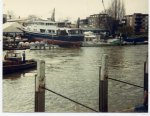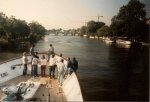Richard Shead
Slipped Anchor
To be fair there have been others....
http://en.wikipedia.org/wiki/Richmond_Bridge,_London


This was Sir Donald Goslings Brave Goose being launched and just before she got stuck under the bridge.
http://en.wikipedia.org/wiki/Richmond_Bridge,_London


This was Sir Donald Goslings Brave Goose being launched and just before she got stuck under the bridge.


